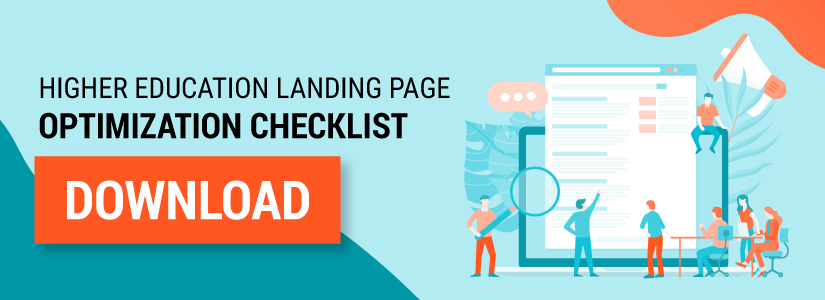Written By:
Eric Bakken
Colleges and Universities offer a wide variety of programs each designed for a specific set of students who’ve attained a certain level of education. Because no two programs or groups of prospective students are the same, taking a cookie-cutter approach to landing page development isn’t effective when marketing your programs.
To help you optimize your higher education landing pages we’ve put together this in-depth guide that walks through auditing your landing pages to find opportunities that increase conversion rate.
The process of moving through the enrollment funnel can take prospective students months - even years. After raising awareness through digital marketing campaigns such as Google Ads and organic efforts you will need to encourage prospects to take the first step in their customer journey and become qualified leads. This will be the moment that your prospective student clicks your call to action and navigates to a landing page. The key to getting these prospects to take the desired action is by ensuring you have a well-designed high-converting landing page that speaks to that prospective student in place. Through optimizing your existing landing pages you can increase the conversion rate and send more prospective students to the consideration stage.
What areas of my landing page can I optimize?
1. Landing page relevancy & clarity
When optimizing your landing page we recommend you start by checking the page’s relevancy and clarity. Think about the conversion path and steps your prospective student has taken to get to the page. Make sure the offer and landing page content aligns with the ad copy or content they were previously viewing. In the event that you have several sources pointing to this landing page containing different messaging, it’s important that you create separate dedicated landing page versions for each of these sources.The next item to check is the headlines. Make sure that the offer and immediate value are clearly stated in your headlines. This item is especially important given that 80% of visitors are likely to make a decision after reading only the headlines. A strong headline will keep your prospective students engaged and more inclined to read the copy, leading to a lower bounce rate.
From here, make sure the landing page copy is focused on the offer and includes enough details for an ideal student to make a decision about converting. Directly state who the offer is for, why the target audience should earn this degree, and why they should pick this institution over competitors. Ensure the copy is written at an appropriate grade level while catering to the prospect’s stage in the enrollment funnel.
In addition to this, you should include relevant information about the program of interest that the potential student will need to know. Examples of this include the university’s address, the program format, and the full application process.
Review how relevant your landing page is by checking if:
- Page aligns and expands upon offer used in ad copy or content.
- Headlines describe offer and immediate value to prospects.
- Directly states who it is for, why they should earn this degree, and why they should pick this institution.
- Copy includes a description of offer and program with enough detail to make a decision.
- Landing page caters to prospect’s stage in the enrollment funnel.
View our complete list of items to optimize. Download our free landing page checklist for higher education!
2. Landing page design
The design of your landing pages and website determine how your prospects perceive your institution. A well-designed college landing page will ease your prospect’s anxiety to provide information by positioning your landing page as legitimate, trustworthy, and of high quality.To audit your landing page’s design you should review your page responsiveness, loading time, and mobile-friendliness score. These are essential to your landing page’s search engine optimization and are the foundation of every effective landing page. You can verify these items and see what improvements need to be made by using a landing page optimization tool such as Lighthouse. You can gain additional information about page performance in Google Analytics.
Take some time to scroll through the landing page and make sure the call to action button(s) and capture form align with your institution’s branding while contrasting the page’s background. White space should be used strategically to help guide the prospect's eyes to page elements. While checking the form, verify the fields only ask for what is needed. This is also a good time to take note of any distracting landing page elements on the page such as navigation links or other items that may provide an exit link for prospects. The single goal in mind here should be to make the submission process as smooth as possible.
Next, ensure that the landing page matches the university’s website design and that the text is large, legible, and has sufficient contrast. Study the current images used on the page and make sure they are relevant to the offer, offer visual appeal, and add to the user’s experience. Two images you definitely want to include are the institution’s logo (placed above the fold) and a captivating image showing real students in a classroom setting. These items will help ease anxiety by letting prospective students know they are dealing directly with your trusted institution and help promote the program.
Review your landing page’s design by checking if:
- Page is responsive, has a quick loading speed, and is mobile-friendly.
- Easy to navigate with no distracting elements or exit links (such as navigation links).
- Colors used on the landing page match university branding.
- Institution logo is visible above the fold.
- Includes a captivating image of real students in a classroom setting. No stock photos.
- CTA button stands out, aligns with university branding, and is placed in multiple areas (for longer landing pages).
- Form is placed directly on the landing page, contrasts the background, and is easy to locate.
Audit your existing landing pages. Download our free higher education landing page checklist now!
3. Urgency & tone
There should be a sense of urgency throughout the copy that encourages the prospective student to take the desired action now instead of holding off to think about it. This can be achieved in several ways, but including a cap on the offer such as a certain number of seats available can help create urgency. Be sure to include key deadlines for submitting an application and for enrolling in the program as well. After discussing the offer make sure you follow up with a clear call to action that directs prospects to take action and fill out the form fields on the landing page. You’ll want to be as specific as possible in this step.Looking at tone, your landing page should be conveying a positive, uplifting, and encouraging message. You shouldn’t try to lecture or push prospects into taking action. They’ve already expressed interest in the offer by navigating to this page so you should encourage the prospect and enable them to become excited by this offer. Take into account your University’s brand voice during this process and ensure the language used is what the prospect has come to expect of your university.
Review the landing page tone and urgency by checking if:
- Key deadlines for application and program enrollment are included.
- Copy conveys a positive, uplifting, and encouraging message.
- Copy creates a sense of urgency (ie, application deadlines, only # spots available).
- Copy includes a call to action that directs prospects to the form.
- Copy creates a sense of anticipation.
- Copy matches the university’s brand voice.
- Form does not try to qualify, only to capture.
4. Supporting elements & other considerations
Include supporting elements that help your University reinforce credibility and trust while providing insight into the offer. Social proof such as testimonials, reviews, or recommendations accompanied by photos is a great way to show the success of your program from an unbiased person who was once in the same position as the prospect. Including rankings, accreditations, and program facts will also aid in supporting the program.Provide a closer look at the program by including sections below the fold that highlight program courses, internship placements, program/career outcomes, short profiles of notable program faculty, and a program overview landing page video. These items will help prospects make a decision by seeing what they will learn, who will teach them, potential opportunities, and if the outcome aligns with their career goals.
To help prospects address any concerns or questions they have you may want to consider including a staffed live chat or chatbot feature on the landing page. A privacy policy should also be linked on the page in the footer or on the form. These key features can be a valuable resource and lead to a higher average landing page conversion rate by providing assistance or answers to questions that may be standing in their way of submitting the form. Social network icons and links to share the page should also be placed on the page so your prospects can pass the offer along to other people who may be interested.
Review the supporting elements on your landing page:
- Includes social proof of at least 2 testimonials, reviews, or recommendations with accompanying photo(s).
- Includes relevant rankings, accreditations, and certifications that reinforce credibility (below the fold).
- Includes a program overview landing page video.
- Contains short profiles of notable program faculty.
- Clearly states program outcomes and career placements.
- Clearly states the program's internship or co-op placements.
- Includes a summary of courses and electives.
Apply These Items To Your Existing Landing Pages.
As you can see, there are many items to consider that contribute to the success of a higher education consideration stage landing page. We’ve put all this information into a free downloadable checklist to help you identify the exact landing page optimizations that will increase your landing page conversion rate. This checklist will provide you with a starting point and walk you through each area of your landing page to help you pinpoint the items that need to be included, removed, or optimized.
If you’re unsure where to start or you’d like to discuss your higher education inbound digital marketing strategy feel free to schedule a free assessment with Pepperland Marketing’s reputable strategists. We are happy to help you identify the best path forward to improve your in-bound enrollment strategy to help you meet your enrollment goals.








